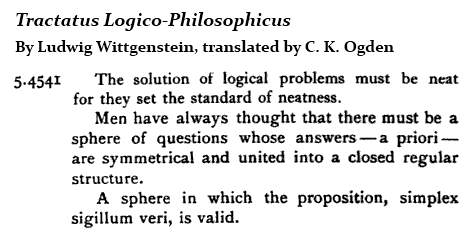Philosophical Investigations (1953)—
97. Thought is surrounded by a halo.
—Its essence, logic, presents an order,
in fact the a priori order of the world:
that is, the order of possibilities * ,
which must be common to both world and thought.
But this order, it seems, must be
utterly simple . It is prior to all experience,
must run through all experience;
no empirical cloudiness or uncertainty can be allowed to affect it
——It must rather be of the purest crystal.
But this crystal does not appear as an abstraction;
but as something concrete, indeed, as the most concrete,
as it were the hardest thing there is
(Tractatus Logico-Philosophicus No. 5.5563).
— Translation by G.E.M. Anscombe
5.5563
All propositions of our colloquial language
are actually, just as they are, logically completely in order.
That simple thing which we ought to give here is not
a model of the truth but the complete truth itself.
(Our problems are not abstract but perhaps
the most concrete that there are.)
97. Das Denken ist mit einem Nimbus umgeben.
—Sein Wesen, die Logik, stellt eine Ordnung dar,
und zwar die Ordnung a priori der Welt,
d.i. die Ordnung der Möglichkeiten ,
die Welt und Denken gemeinsam sein muß.
Diese Ordnung aber, scheint es, muß
höchst einfach sein. Sie ist vor aller Erfahrung;
muß sich durch die ganze Erfahrung hindurchziehen;
ihr selbst darf keine erfahrungsmäßige Trübe oder Unsicherheit anhaften.
——Sie muß vielmehr vom reinsten Kristall sein.
Dieser Kristall aber erscheint nicht als eine Abstraktion;
sondern als etwas Konkretes, ja als das Konkreteste,
gleichsam Härteste . (Log. Phil. Abh. No. 5.5563.)
See also—
Related language in Łukasiewicz (1937)—

* Updates of 9:29 PM ET July 10, 2011—
A mnemonic from a course titled “Galois Connections and Modal Logics“—
“Traditionally, there are two modalities, namely, possibility and necessity.
The basic modal operators are usually written  (square) for necessarily
(square) for necessarily
and  (diamond) for possibly. Then, for example,
(diamond) for possibly. Then, for example,  P can be read as
P can be read as
‘it is possibly the case that P .'”
| See also Intensional Semantics , lecture notes by Kai von Fintel and Irene Heim, MIT, Spring 2007 edition—
“The diamond ⋄ symbol for possibility is due to C.I. Lewis, first introduced in Lewis & Langford (1932), but he made no use of a symbol for the dual combination ¬⋄¬. The dual symbol □ was later devised by F.B. Fitch and first appeared in print in 1946 in a paper by his doctoral student Barcan (1946). See footnote 425 of Hughes & Cresswell (1968). Another notation one finds is L for necessity and M for possibility, the latter from the German möglich ‘possible.’”
Barcan, Ruth C.: 1946. “A Functional Calculus of First Order Based on Strict Implication.” Journal of Symbolic Logic, 11(1): 1–16. URL http://www.jstor.org/pss/2269159.
Hughes, G.E. & Cresswell, M.J.: 1968. An Introduction to Modal Logic. London: Methuen.
Lewis, Clarence Irving & Langford, Cooper Harold: 1932. Symbolic Logic. New York: Century.
|





